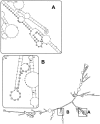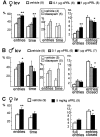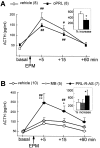Anxiolytic and anti-stress effects of brain prolactin: improved efficacy of antisense targeting of the prolactin receptor by molecular modeling
- PMID: 11312305
- PMCID: PMC6762563
- DOI: 10.1523/JNEUROSCI.21-09-03207.2001
Anxiolytic and anti-stress effects of brain prolactin: improved efficacy of antisense targeting of the prolactin receptor by molecular modeling
Abstract
We provide the first evidence that prolactin is a neuromodulator of behavioral and neuroendocrine stress coping in the rat. In virgin female and male rats, intracerebral infusion of ovine prolactin (oPRL) into the lateral cerebral ventricle (intracerebroventricular) exerted an anxiolytic effect on the elevated plus-maze in a dose-dependent manner (0.1 and 1.0 microg/5 microl; p < 0.01). In contrast, downregulation of the expression of the long form of brain prolactin receptors by chronic intracerebroventricular infusion of an antisense oligodeoxynucleotide (ODN) (osmotic minipump, 0.5 microg. 0.5 microl(-1). hr(-1); 5 d) increased anxiety-related behavior on the plus-maze compared with mixed bases-treated and vehicle-treated rats (p < 0.01), again demonstrating an anxiolytic effect of PRL acting at brain level. Furthermore, in jugular vein-catheterized female rats, the stress-induced increase of corticotropin secretion was decreased after chronic intracerebroventricular infusion of oPRL (osmotic minipump, 1.0 microg. 0.5 microl(-1). hr(-1); p < 0.05) and, in contrast, was further elevated by antisense targeting of the brain prolactin receptors (p < 0.01). This provides evidence for a receptor-mediated attenuation of the responsiveness of the hypothalamo-pituitary-adrenal (HPA) axis by prolactin. The antisense ODN sequence was selected on the basis of secondary structure molecular modeling of the target mRNA to improve antisense ODN-mRNA hybridization. Receptor autoradiography confirmed the expected improvement in the efficacy of downregulation of prolactin receptor expression [empirically designed antisense, 30%; p > 0.05, not significant; adjustment of target position after mRNA modeling, 72%; p < 0.05). Taken together, prolactin acting at brain level has to be considered as a novel regulator of both emotionality and HPA axis reactivity.
Figures





Similar articles
-
Increased hypothalamic expression of prolactin in lactation: involvement in behavioural and neuroendocrine stress responses.Eur J Neurosci. 2002 Apr;15(8):1381-9. doi: 10.1046/j.1460-9568.2002.01965.x. Eur J Neurosci. 2002. PMID: 11994132
-
Chronic intracerebral prolactin attenuates neuronal stress circuitries in virgin rats.Eur J Neurosci. 2007 Mar;25(6):1804-14. doi: 10.1111/j.1460-9568.2007.05416.x. Eur J Neurosci. 2007. PMID: 17432967
-
Differential behavioural effects of chronic infusion of CRH 1 and CRH 2 receptor antisense oligonucleotides into the rat brain.J Psychiatr Res. 1999 Mar-Apr;33(2):153-63. doi: 10.1016/s0022-3956(98)80047-2. J Psychiatr Res. 1999. PMID: 10221747
-
The brain prolactin system: involvement in stress response adaptations in lactation.Stress. 2002 Dec;5(4):249-57. doi: 10.1080/1025389021000048638. Stress. 2002. PMID: 12475729 Review.
-
[Specific regulation of gene expression in brain by antisense oligodeoxynucleotides].Nihon Yakurigaku Zasshi. 1997 Apr;109(4):187-91. doi: 10.1254/fpj.109.187. Nihon Yakurigaku Zasshi. 1997. PMID: 9160348 Review. Japanese.
Cited by
-
Brief Pup Separation in Lactation Confers Stress Resistance with Increased Prolactin and Adult Hippocampal Neurogenesis in Postpartum C57BL/6J Dams.Neurochem Res. 2024 Nov;49(11):3143-3155. doi: 10.1007/s11064-024-04231-8. Epub 2024 Sep 5. Neurochem Res. 2024. PMID: 39235577
-
Effects of High-Fat Diet on Stress Response in Male and Female Wildtype and Prolactin Knockout Mice.PLoS One. 2016 Nov 28;11(11):e0166416. doi: 10.1371/journal.pone.0166416. eCollection 2016. PLoS One. 2016. PMID: 27893788 Free PMC article.
-
Growth hormone receptor in dopaminergic neurones regulates stress-induced prolactin release in male mice.J Neuroendocrinol. 2021 Mar;33(3):e12957. doi: 10.1111/jne.12957. J Neuroendocrinol. 2021. PMID: 33769619 Free PMC article.
-
Prolactin prevents chronic stress-induced decrease of adult hippocampal neurogenesis and promotes neuronal fate.J Neurosci. 2009 Feb 11;29(6):1826-33. doi: 10.1523/JNEUROSCI.3178-08.2009. J Neurosci. 2009. PMID: 19211889 Free PMC article.
-
Prolactin-induced neuroprotection against glutamate excitotoxicity is mediated by the reduction of [Ca2+]i overload and NF-κB activation.PLoS One. 2017 May 5;12(5):e0176910. doi: 10.1371/journal.pone.0176910. eCollection 2017. PLoS One. 2017. PMID: 28475602 Free PMC article.
References
-
- Abel EL. A further analysis of physiological changes in rats in the forced swim test. Physiol Behav. 1994;56:795–800. - PubMed
-
- Alvarez EO, Banzan AM. Behavioural actions of prolactin locally applied into the hippocampus of adult female rats. J Neural Transm Gen Sect. 1994;95:17–28. - PubMed
-
- Arborelius L, Owens MJ, Plotsky PM, Nemeroff CB. The role of corticotropin-releasing factor in depression and anxiety disorders. J Endocrinol. 1999;160:1–12. - PubMed
-
- Asher I, Kaplan B, Modai I, Neri A, Valevski A, Weizman A. Mood and hormonal changes during late pregnancy and puerperium. Clin Exp Obstet Gynecol. 1995;22:321–325. - PubMed
-
- Bakowska JC, Morrell JI. Atlas of the neurons that express mRNA for the long form of the prolactin receptor in the forebrain of the female rat. J Comp Neurol. 1997;386:161–177. - PubMed
Publication types
MeSH terms
Substances
LinkOut - more resources
Full Text Sources
Other Literature Sources
Medical
